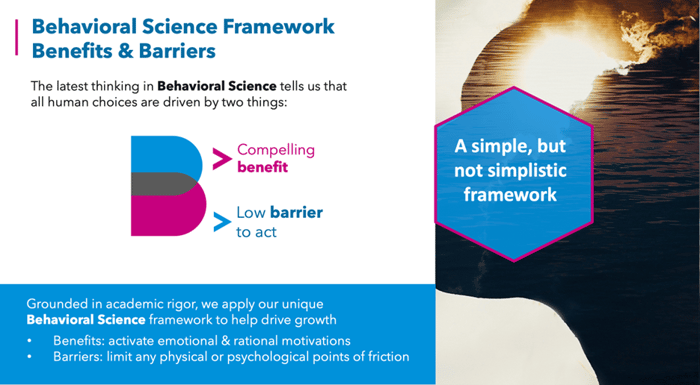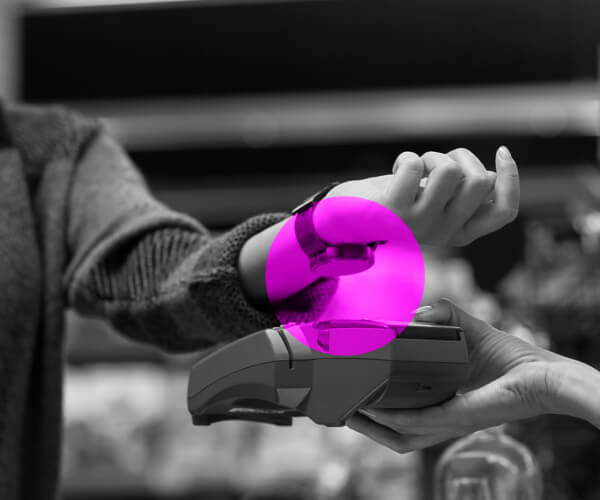A Case for Simple, Actionable Behavioral Research – Post 2
In our last post, we made the case for behavioral science and our own unique approach to making it a simple framework for exploring clients’ marketing challenges. To reiterate focus on two metrics to predict a marketing execution’s potential to drive consumer choice in retail, does the product or service have:
- A compelling benefit (e.g., motivation)?
- A low barrier to act (the absence of friction)?
We have seen a lot of other behavioral frameworks and theoretical models that are so complicated, they literally take multiple academic white papers, workshops, and training sessions or a wall poster to explain.
Ironically, the barrier for adoption of behavioral principles within many organizations seems to be their complexity, especially when agencies feel compelled to make them hyper-complex in order to imply that they are serious.
Knowing your C-Suite wants actions, not theories, we developed a simple but not simplistic baseline for our behavioral research. Our goal is to provide reliable behavioral guideposts for your respective strategic challenges that are easy to recognize and adopt when approaching omnichannel shopper marketing and the digital and physical path-to-purchase.
Thus, we distilled down all that we know about shopping behavior from our decades of expertise in the field, refining our framework, essentially to a two-factor metric.
Our framework measures and evaluates Benefits and Barriers as the structure in which to define and diagnose the opportunities along the shopper journey to influence consumers’ choices. Applied effectively, it informs strategies and tactics that lead to the one moment at which marketing value is realized: the moment in which a consumer selects and purchases your product.
What then is the simple explanation of Benefits and Barriers in this context?
- If a brand or product addresses an unmet need, or a way to enhance their lives, a consumer will sense a Benefit and be motivated to buy.
- If a brand or product eliminates friction or a Barrier to act, it is more likely to be selected or chosen and purchased by a consumer.
When research is aligned to define and diagnose the factors that influence those two fundamentals, the framework reveals the actions needed for brands to achieve desired outcomes.
Simple, and at its core: actionable.
There are certainly unique nuances, angles, and specificity in the key strategic challenges clients face that shape shopper behavioral research objectives based on this framework. Much depends on the stage of the product lifecycle at which the research is initiated.
Is the research intended to:
- Support development or launch of a new product?
- Launch a restage or a line extension?
- Enter a new market or geography?
- Defend the potential of being delisted from a retail distribution partner?
- Seize or defend market share against a competitor?
- Optimize the pack image within the constraints of a large e-commerce player’s grid restrictions?
- Identify the complex influences impacting a consumer along their path-to-purchase?
- Refine the strategy for a DTC program without jeopardizing other retail channels?
These objectives may form the big-picture questions brands need to explore in shopper research, but your C-Suite wants easy-to-understand research results and recommendations for what to do next that are grounded in sound actionable behavioral principles.
At Behaviorally, we believe that whether we are evaluating packaging, POSM or pricing, the context in which a product is seen, or the omnichannel shopper journey that brings a consumer to the moment of choice, our behavioral framework needs to be this simple:
- Benefits or motivations can be emotional or rational, but they must be compelling enough to prompt shopper choice at an instinctive level.
- Does your shopper marketing convey enough Benefit to be a motivation to consider and buy a product?
- Barriers can be physical, mental or involve lack of clarity. However they are manifested, Barriers will slow down or even derail shopper choice and you risk a purchase being lost.
- Does your shopper marketing execution remove enough friction so as not to be a Barrier to consumer choice at the digital or physical shelf?
And if the answer to either is “no”, then the research must also provide tangible steps a brand can take to correct the deficit and drive the purchase choice.
That is our simple, but not simplistic, framework, and we can prove it works.
In our next post in this series, we will explore in depth the academic rigor that informs our unique application of behavioral science to help clients enable the most important moment in marketing: the purchase transaction.
In the meantime, if you want to know more about applying this framework to your own retail challenges, please contact your local Behaviorally expert.

